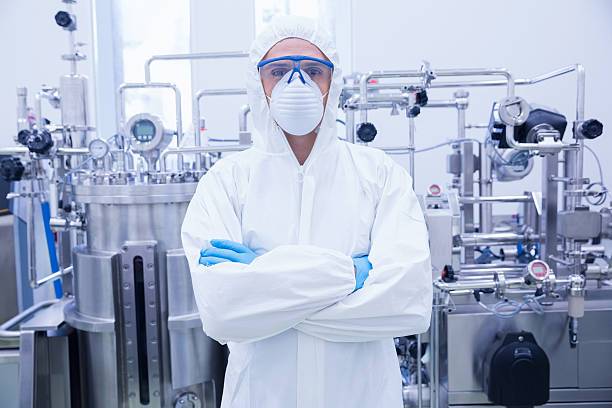by Haoxin Safety
Share
by Haoxin Safety
Share

Safety should always be a top priority in any work environment, especially when dealing with hazardous materials. That’s why microporous coveralls have become an essential piece of protective equipment for workers. These coveralls are designed to keep workers safe from harmful chemicals, dust, and other hazardous materials that could cause serious health problems. With their unique fabric construction, microporous coveralls provide a barrier against even the smallest particles, while still allowing for breathability and comfort. In this article, we’ll explore why microporous coveralls are so important for hazardous work environments and how they can help keep workers safe and protected on the job. So, if you want to ensure the safety of your workers and create a hazard-free workplace, read on to learn more about the benefits of microporous coveralls.
Hazards in the Workplace
Every workplace poses some level of risk to employees. However, some jobs come with more danger than others. For example, workers in the chemical industry, pharmaceuticals, and healthcare sectors are regularly exposed to hazardous chemicals, toxins, and biological agents that can harm their health. Additionally, workers in construction, mining, and manufacturing industries are often exposed to dust, debris, and other particles that can cause respiratory problems. Exposure to these hazards can lead to both short-term and long-term health problems. Therefore, it’s vital to take all precautions necessary to keep workers safe from harm.
Importance of Protective Clothing
One of the most effective ways of protecting workers from hazardous materials is through the use of protective clothing. Protective clothing acts as a barrier between the worker’s skin and the hazardous material, preventing direct contact. It also helps prevent the inhalation of harmful particles, especially those that are too small to see. Protective clothing includes items such as gloves, boots, goggles, respirators, and coveralls. Coveralls are particularly useful in hazardous environments because they cover the entire body, reducing the risk of exposure to hazardous materials.
How Microporous Coveralls Work
Microporous coveralls are made from a unique fabric that is designed to provide a barrier against hazardous materials. The fabric is made up of tiny pores that are too small for particles to pass through, but large enough to allow air and water vapor to escape. This allows the wearer to stay cool and comfortable while still being protected from harmful particles. Microporous coveralls are also lightweight and flexible, making them easy to move around in. Additionally, they are resistant to tears and punctures, ensuring that they provide a long-lasting barrier against hazardous materials.
Benefits of Microporous Coveralls
One of the most significant benefits of microporous coveralls is their ability to protect workers from hazardous materials. They provide an effective barrier against chemicals, dust, and other harmful particles, reducing the risk of exposure to workers. Additionally, they are comfortable to wear, allowing workers to move freely without feeling restricted. They are also relatively inexpensive, making them an affordable option for companies looking to provide their workers with protective clothing. Microporous coveralls are also easy to put on and take off, reducing the time it takes to get ready for work.
Comparison with Other Protective Clothing
While there are many types of protective clothing available, microporous coveralls have some unique advantages. For example, they provide a barrier against even the smallest particles, such as those found in hazardous chemicals. This is not always the case with other types of protective clothing, such as cotton or polyester coveralls. Additionally, microporous coveralls are lightweight and breathable, making them more comfortable to wear than heavier materials like rubber or PVC. However, it’s essential to choose the right protective clothing for the job. For example, workers in the construction industry may need heavier protective clothing to protect against falling debris.
Factors to Consider when Choosing Microporous Coveralls
When choosing microporous coveralls, there are several factors to consider. First, it’s essential to choose the right size to ensure a proper fit. This will help prevent the coveralls from tearing or ripping and will also prevent any gaps where particles could enter. Additionally, it’s important to choose coveralls that are designed for the specific hazards of the job. For example, some microporous coveralls are designed to protect against chemical splashes, while others are designed for dust and debris. Finally, it’s important to choose coveralls that are compliant with industry standards and regulations.
Industry Standards and Regulations
There are many industry standards and regulations that govern the use of protective clothing in hazardous work environments. For example, the Occupational Safety and Health Administration (OSHA) has specific regulations for the use of protective clothing in the workplace. Additionally, there are industry-specific regulations that apply to certain types of hazards, such as the Hazardous Waste Operations and Emergency Response Standard (HAZWOPER) for workers in the chemical industry. It’s essential to understand and comply with these regulations to ensure the safety of workers.
Conclusion
In conclusion, microporous coveralls are an essential piece of protective equipment for workers in hazardous work environments. They provide a barrier against hazardous materials, reducing the risk of exposure to workers. Additionally, they are comfortable to wear and relatively inexpensive, making them an affordable option for companies. When choosing microporous coveralls, it’s important to consider the specific hazards of the job and to choose coveralls that comply with industry standards and regulations. By taking these steps, companies can help ensure the safety and well-being of their workers.
